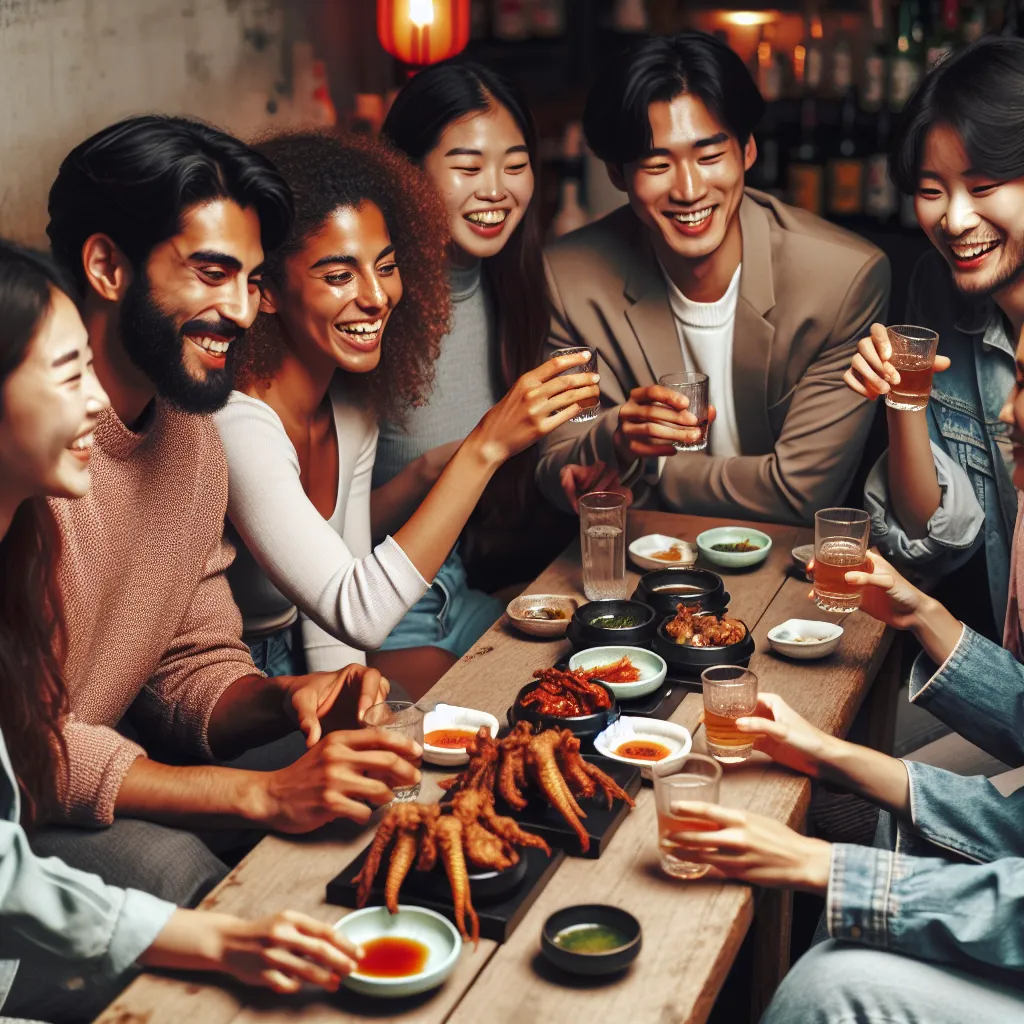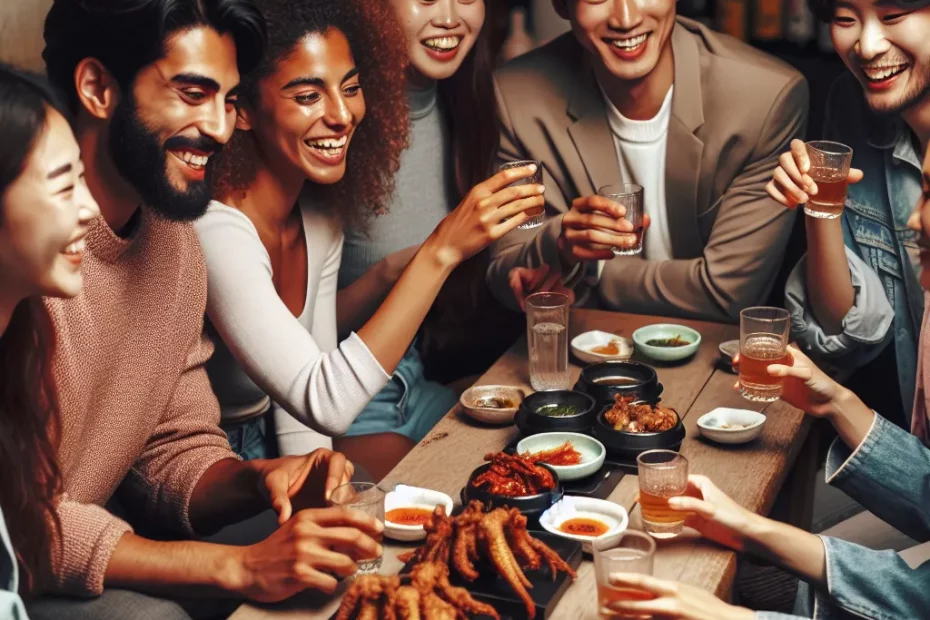In South Korea, the drinking culture surrounding soju is deeply ingrained in the social fabric, reflecting centuries-old traditions and customs. From the selection of anju foods to the etiquette and customs of soju drinking, every aspect of this cultural phenomenon carries significance. Soju, Korea’s favorite alcohol, not only serves as a beverage but also as a symbol of camaraderie and social bonding. Understanding the rituals and practices associated with soju nights provides valuable insights into Korean society and its values. Let’s delve into the rich tapestry of soju culture, exploring its nuances and the role it plays in fostering connections among people.

The Tradition of Anju Foods
In the vibrant drinking culture of Korea, the tradition of Anju foods holds a special place. Anju, which refers to the delicious dishes enjoyed alongside alcoholic beverages, plays a crucial role in enhancing the overall drinking experience. These savory treats are carefully selected to complement the flavors of various alcoholic drinks, particularly the popular Korean spirit, Soju. 🍶
The Significance of Anju Foods
Anju foods are not just random snacks but are chosen with great consideration to create a harmonious balance of flavors. From spicy chicken feet to crispy fried dumplings, each Anju dish is designed to elevate the taste of the drink it accompanies. The variety of Anju options available cater to different preferences, ensuring that there is something for everyone to enjoy while indulging in a night of drinking. 🍗🥟
Iconic Anju Foods
One of the most iconic Anju foods in Korea is “Pajeon,” a savory pancake made with green onions and seafood. This dish is a favorite among locals and foreigners alike, thanks to its crispy texture and rich flavors. Another popular choice is “Tteokbokki,” spicy stir-fried rice cakes that provide a perfect combination of heat and chewiness, making them an ideal companion for Soju. 🥢🔥
Social Function of Anju Foods
In addition to enhancing the taste of alcoholic beverages, Anju foods also serve a social function in Korean drinking culture. Sharing these dishes with friends and colleagues fosters camaraderie and strengthens relationships, making the act of drinking together a bonding experience. The communal aspect of enjoying Anju foods reflects the importance of social connections in Korean society. 🎉👫
Continuing Tradition
As the night progresses and glasses are raised in celebration, the tradition of Anju foods continues to play a significant role in shaping the drinking culture of Korea. Whether it’s a casual gathering or a festive occasion, the presence of these delectable dishes adds an extra layer of enjoyment to the drinking experience, creating memories that last a lifetime. 🌟🍻
In conclusion, the tradition of Anju foods in Korea is not just about eating and drinking; it’s about coming together, sharing moments of joy, and savoring the flavors of both the food and the company. So, the next time you raise a glass of Soju, remember to pair it with some delicious Anju and immerse yourself in the rich tapestry of Korean drinking culture. Cheers to good food, great company, and unforgettable nights! 🌙🍽️
Soju: Korea’s Favorite Alcohol
In the vibrant drinking culture of South Korea, one beverage stands out above the rest – soju. This clear, colorless distilled spirit has become an integral part of Korean social gatherings, celebrations, and everyday life. With its clean taste, high alcohol content, and affordable price, soju has captured the hearts of many Koreans and visitors alike. 🍶
The Origin of Soju
Derived from rice, barley, wheat, or sweet potatoes, soju typically contains around 16-25% alcohol by volume. Its versatility in cocktails and its ability to be enjoyed neat or with a variety of mixers make it a popular choice among drinkers of all ages. Whether it’s a casual night out with friends or a festive occasion, soju is often the drink of choice in Korea. 🎉
The Cultural Significance
One of the most fascinating aspects of soju is its cultural significance. In Korean society, sharing a bottle of soju is a way to bond, show respect, and strengthen relationships. The tradition of pouring drinks for others, known as “pouring culture,” is deeply ingrained in Korean social etiquette. It is not just about the act of drinking, but about the connections and camaraderie that are formed over a shared bottle of soju. 🥂
Flavored Soju
In recent years, flavored soju has gained popularity, offering a modern twist on the traditional spirit. From fruity flavors like peach and grape to unique options like yogurt and green tea, the variety of choices caters to a wide range of tastes. This innovation has helped soju maintain its relevance in a rapidly changing drinking landscape. 🍑
Whether you’re savoring the classic taste of original soju or exploring the latest flavor trends, one thing is certain – soju holds a special place in Korean culture and hearts. Its ability to bring people together, create memories, and spark joy is truly unparalleled. So, the next time you find yourself in Korea, raise a glass of soju and experience the magic of this beloved national drink. Cheers to the spirit of soju! 🇰🇷🥳
Etiquette and Customs of Soju Drinking
In South Korea, soju holds a special place in the hearts of locals and visitors alike. This clear, distilled spirit is not just a drink but a cultural symbol deeply ingrained in social gatherings and celebrations. Understanding the etiquette and customs surrounding soju drinking is essential for anyone looking to fully immerse themselves in Korean drinking culture.
Pouring Protocol
When pouring soju for others, it is customary to use both hands as a sign of respect. Hold the bottle with one hand and use the other hand to support your pouring hand. This gesture shows politeness and consideration towards your drinking companions.
Accepting a Drink
When receiving a glass of soju, hold it with both hands to show gratitude. It is also polite to turn your head slightly to the side when receiving a drink, especially from someone older or of higher status. This gesture demonstrates humility and respect.
Cheers Ritual
Before taking the first sip, it is common to make a toast by saying “건배 (geonbae)” which means cheers. Make eye contact with everyone at the table while clinking glasses. Remember, it is considered impolite to drink alone in a group setting, so always wait for everyone to be ready before taking a sip.
Respectful Refills
Keep an eye on your companions’ glasses and refill them when they are empty. If someone offers to refill your glass, tilt it slightly towards them as a sign of acceptance. This back-and-forth refilling symbolizes camaraderie and bonding among drinkers.
Eating and Drinking
In Korean drinking culture, food and alcohol go hand in hand. It is common to enjoy various side dishes (banchan) while drinking soju. Pace yourself and avoid drinking on an empty stomach to prevent overindulgence.
Know Your Limits
While the convivial atmosphere may tempt you to keep up with the drinking pace, it is important to know your limits. If you feel uncomfortable or too intoxicated, it is perfectly acceptable to politely decline further drinks. Your well-being should always come first.
So, the next time you find yourself in a lively soju night in Korea, remember these etiquette and customs to fully embrace the rich drinking culture of the country. Cheers to good company, delicious food, and memorable experiences! 🥂
Soju Drinking Games and Socializing
In the vibrant nightlife of South Korea, soju drinking games play a significant role in socializing and bonding among friends and colleagues. Soju, a popular Korean alcoholic beverage, is often enjoyed in a group setting, where various drinking games add an extra layer of fun and camaraderie to the experience. From traditional games like “Baskin Robbins 31” to modern twists on classics like “Titanic,” these games not only test your drinking skills but also create lasting memories with those you share the soju table with. 🍶🎲
Well-Known Soju Drinking Games
One of the most well-known soju drinking games is “Flick the Cap,” where participants take turns flicking the cap of the soju bottle. The direction in which the cap points after being flicked determines who the next drinker will be. This game adds an element of chance and excitement to the drinking session, keeping everyone on their toes and engaged in the fun. 🔄🍻
Another popular game is “Subway Game,” where each player takes turns saying a number in sequence. However, if the number contains a 3 or is a multiple of 3, the player must change the direction of play. This fast-paced game not only tests your mental agility but also leads to hilarious moments as players try to keep up with the changing sequence. 🚇🔢
Newer Variations of Soju Drinking Games
In addition to these traditional games, newer variations like “Soju Pong” have gained popularity among the younger crowd. Similar to beer pong, players aim to throw a ping pong ball into their opponent’s soju cup. If successful, the opponent must drink the contents of the cup, adding a competitive edge to the social gathering. 🏓🥤
Beyond the entertainment value, soju drinking games serve as a social lubricant, breaking down barriers and fostering connections among participants. The shared experience of playing these games creates a sense of camaraderie and unity, strengthening bonds and creating lasting friendships. So whether you’re a seasoned soju drinker or a newcomer to the scene, participating in these games is a surefire way to immerse yourself in Korean drinking culture and make unforgettable memories. Cheers to the joy of soju nights and the camaraderie they bring! 🎉🇰🇷
As the night falls in Korea, soju bottles are uncorked, and the drinking culture comes alive. From the tradition of pairing soju with anju foods to the various drinking games and customs, the social significance of soju nights runs deep in Korean society. Soju, Korea’s favorite alcohol, not only serves as a beverage but also as a social lubricant that brings people together. Understanding the etiquette of soju drinking is crucial for anyone looking to immerse themselves in Korean drinking culture. So, whether you’re a visitor or a local, embracing the rituals and customs of soju nights will undoubtedly enhance your experience and deepen your connection with the vibrant Korean community. Cheers to the rich tapestry of traditions and camaraderie that make soju nights in Korea truly unforgettable.
